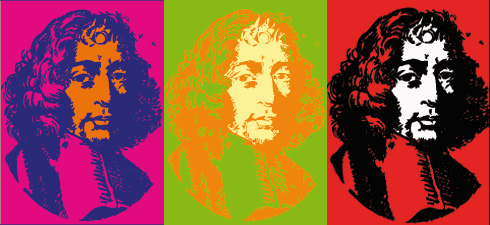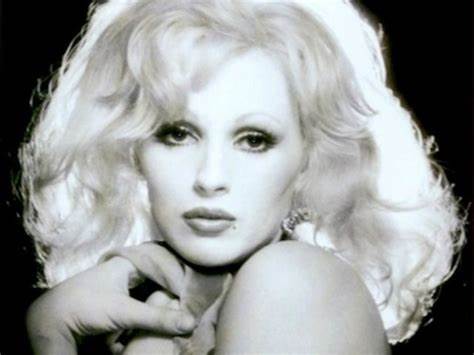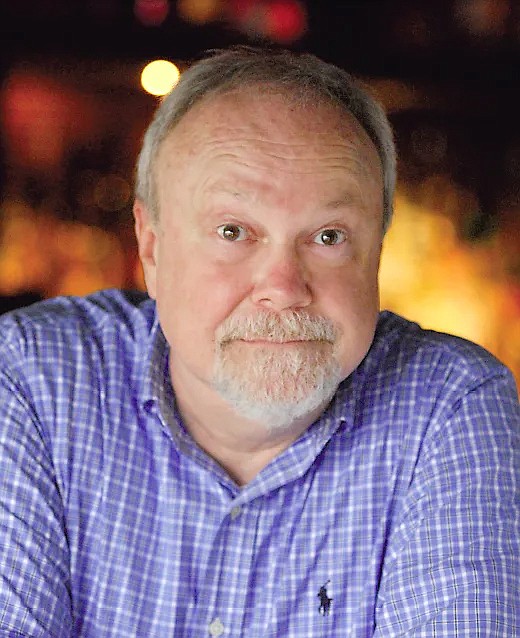November 24
BARUCH SPINOZA, Dutch philosopher was born (d.1677); One of the great rationalists of 17th century philosophy, he laid the groundwork for the 18th century Enlightenment and modern biblical criticism.
By virtue of his magnum opus, the posthumous Ethics, Spinoza is also considered one of Western philosophy's definitive ethicists. He was raised and educated in the Orthodox Jewish fashion, also studying Latin and was thoroughly familiar with European humanism. What exactly is it that caused him to be excommunicated from the synagogue when he was only twenty-four years old?
Many scholars have speculated that the horror Spinoza inspired in the Jewish community may have come not only from his espousal of advanced economic theories, but from his espousal, as well, of "Greek love" among impressionable students in the liberal circle where he taught. A Dutch physician, J. Roderpoort, wrote at The Hague in 1897: “Spinoza excites the youth to respect women not at all and to give themselves to debauchery.”
Was Spinoza merely teaching the Greek and Roman classics, with their inevitable passages on pederasty? What were Roderpoort’s motives for discrediting the Jewish philosopher? Was Spinoza, in fact a pederast? It’s all open to speculation.
CANDY DARLING, born on this date (d: 1974), was an American actress, best known as a Warhol superstar and transgender icon. She starred in Andy Warhol's films Flesh (1968) and Women in Revolt (1971), and was a muse of The Velvet Underground.
Born in Forest Hills, Queens, she was the child of Theresa Slattery, a bookkeeper at Manhattan's Jockey Club, and James ("Jim") Slattery, who was described as a violent alcoholic.
Darling's early years were spent in Massapequa Park, Long Island, where she and her mother moved after her parents' divorce. She spent much of her childhood watching television and old Hollywood movies, from which she learned to impersonate her favorite actresses such as Joan Bennett and Kim Novak. Darling took a strong interest in the Million Dollar Movie broadcast on television, which she would often watch several times a day. Inspired in part by Novak, Darling began to model her life around "Hollywood glamour-queen prettiness." She had one half-brother, Warren Law II, from her mother's first marriage, to Warren Law. Warren Law II left to serve in the United States military and left Darling as the only child. Law would later deny his connection to Darling.
In a biography about Darling, Cynthia Carr reveals that Darling was "relentlessly bullied" in high school and dropped out at the age of 16 after a group of boys tried to lynch her.
In 1961, she signed up for a course at the DeVern School of Cosmetology in Baldwin, Long Island. Darling later said that she "learned about the mysteries of sex from a salesman in a local children's shoe store" and finally revealed an inclination towards cross-dressing when her mother confronted her about local rumors, which described Darling as "dressing as a girl" and frequenting a local gay bar called The Hayloft. In response, Darling left the room and returned in feminine clothing. Darling's mother would later say that, "I knew then... that I couldn't stop [her]. Candy was just too beautiful and talented."
After coming out publicly, Darling would take a short cab ride to the Long Island Rail Road station, avoiding the attention of neighbors she would receive by walking to the train. From there, she would take the train to Manhattan, often sitting across from Long Island starlet Joey Heatherton. In Manhattan, she would refer to her family home at 79 First Avenue in Massapequa Park as her "country house", and spent time in Greenwich Village, meeting people through Seymour Levy on Bleecker Street.
Before they met, in 1967, Darling saw Andy Warhol at The Tenth of Always, an after-hours club. Darling was with Jackie Curtis, who invited Warhol to a play that she had written and directed, called Glamour, Glory and Gold, starring Darling as "Nona Noonan" and a young Robert De Niro, who played six parts in the play.
Warhol cast Darling in a short comedic scene in Flesh (1968) with Jackie Curtis and Joe Dallesandro. After Flesh, Darling was cast in a central role in Women in Revolt (1971).
Women in Revolt was first shown at the first Los Angeles Filmex as Sex. It was later shown as Andy Warhol's Women.
The day after the celebrity preview, a group of women carrying protest signs demonstrated outside the cinema against the film, which they thought was anti-women's liberation. When Darling heard about this, she said, "Who do these dykes think they are anyway? Well, I just hope they all read Vincent Canby's review in today's Times. He said I look like a cross between Kim Novak and Pat Nixon. It's true – I do have Pat Nixon's nose."
Darling worked for a short time as a barmaid at Slugger Ann's, the bar owned by Jackie Curtis's grandmother.
Darling first took the name Hope Slattery. According to Bob Colacello, Darling took this name in 1963/1964 after she started going to gay bars in Manhattan and visiting a doctor on Fifth Avenue for hormone injections. Jackie Curtis said that Darling adopted the name from a well-known Off Broadway actress named Hope Stansbury, with whom she lived for a few months in an apartment behind the Caffe Cino. Holly Woodlawn remembers that Darling's name evolved from Hope Dahl to Candy Dahl, then to Candy Cane. Jeremiah Newton said she took the name "Candy" out of a love for sweets. In her autobiography, Woodlawn recalled that Darling had adopted the name because a friend of hers called her "darling" so often that it stuck.
Darling went on to appear in independent films, including Silent Night, Bloody Night, Wynn Chamberlain's Brand X, and a co-starring role in Some of My Best Friends Are... She appeared in Klute with Jane Fonda and Lady Liberty with Sophia Loren. In 1971, she went to Vienna to make two films with director Werner Schroeter: The Death of Maria Malibran, and another film that was never released. Darling's attempt at breaking into mainstream movies, by campaigning for the leading role in Myra Breckinridge (1970), led to rejection and bitterness.
Darling was in the original 1972 production of Tennessee Williams' play Small Craft Warnings, cast at Williams' request. She starred in the 1973 revival of The White Whore and the Bit Player, a 1964 play by Tom Eyen, at La MaMa Experimental Theatre Club. The production was bilingual, called The White Whore and the Bit Player/La Estrelle y La Monja, and directed by Manuel Martin Jr. Darling's character, a Hollywood actress known only as "the Whore", was based on Marilyn Monroe. Among many other tributes in song, stage and film the second verse of Lou Reed's 1972 "Walk on the Wild Side" is devoted to Darling.
Darling died of lymphoma in March 1974, aged 29, at the Columbus Hospital division of the Cabrini Health Care Center. In a letter written on her deathbed and intended for Warhol and his followers, Darling wrote, "Unfortunately before my death I had no desire left for life ... I am just so bored by everything. You might say bored to death. Did you know I couldn't last. I always knew it. I wish I could meet you all again."
Her funeral, held at the Frank E. Campbell Funeral Chapel, was attended by huge crowds. Julie Newmar read the eulogy. Darling's birth name was never spoken by the minister or any of the eulogizers. Faith Dane played a piano piece, and Gloria Swanson saluted Darling's coffin.
Darling was cremated, and her ashes were interred by Jeremiah Newton in the Cherry Valley Cemetery in Cherry Valley, New York, a village at the foot of the Catskill Mountains.
ROBERT PLUNKETT is an American novelist. We don't have access to his actual birthday, though we know he was born on 1945. Anyone with more information is kindly requested to contact me.
Plunkett is best known for his novel first novel, My Search for Warren Harding, which immediately established him as one of America’s most promising novelists. Unfortunately, the promise soon faded, and he now lives in a trailer in Sarasota, Florida, where he ekes out an existence as a gossip columnist, covering everything from gala charity balls to KKK meetings. He has also served on the boards of Sarasota AIDS Support and the Humane Society of Sarasota County, and is currently running for election to the Mosquito Control Board, District 6.
His novel anticipated and influenced much of what the culture would begin to find funny (and maybe what some of us are still waiting for the world to find funny). In our contemporary humble-bragging world of filtered selfies, virtue signaling, and good optics, we find increasing release, and comic relief, in fictional characters we are not asked to admire or envy—in characters so awful or amoral or vapid that the joke is on them.
Rumor has it that Larry David was such a fan of the novel he kept copies of it available in the Seinfeld writing room and told his writers to imitate the tone. It’s clear reading this novel that he even lifted details from the book, such as the absurd way that Seinfeld’s Elaine dances—clearly based on the novel’s depiction of how Weiner’s girlfriend Pam dances: "She is one of those people who ‘abandon’ themselves to the beat, clapping their hands over their head and emitting little yelps. To make matters worse, she studied modern dance in college and thus considers herself a Movement Expert. The thing she does—I can only describe them as Martha Graham routines. Her arms fly out into space, she makes sudden turns, then she half-squats, her head flung back in ecstasy."
He has also made appearances in film. Notably in the Martin Scorsese film After Hours. (That’s his voice you hear at the beginning of the film’s trailer.) He is also the guy who picks up Griffin Dunne's character. He also acted in (and wrote) Insomnia (1994), and a minor role in Autumn in New York, alongside Winona Ryder and Richard Gere.
His novel “Love Junkie” was published in 1992. In it, Plunket transforms Broadway's Dorothy Rodgers into a clueless and cloying Bronxville housewife, Mimi Smithers. Married to a Union Carbide executive who escaped the Shah’s regime, Mimi wants to impress Mrs. John D. Rockefeller III and the other society ladies. But after her first failed attempt she settles for an unpaid job in the city with an arts organization, where she first falls for her gay boss, Tom Potts.
Then she falls for all of his friends, including Joel, a gay-porn star who turns out not to be gay. She takes over Joel’s mail-order business, sending eager customers his soiled Jockey shorts and cassette tapes from his “Verbal Abuse” series, with titles such as “On Your Knees, Cocksucker, Part Two.” This kind of thing may not be for everyone, but the people who go for it really love it: Madonna reportedly bought the film rights, and, when her option lapsed, Amy Sedaris stepped in.
Robert Plunket lives in a trailer park in Englewood, Fla., with his pug, Meatball.
The Wisdom of Baruch Spinoza
Subscribe to Gay Wisdom
Would you like to have Today in Gay History (aka Gay Wisdom) sent to you daily?




